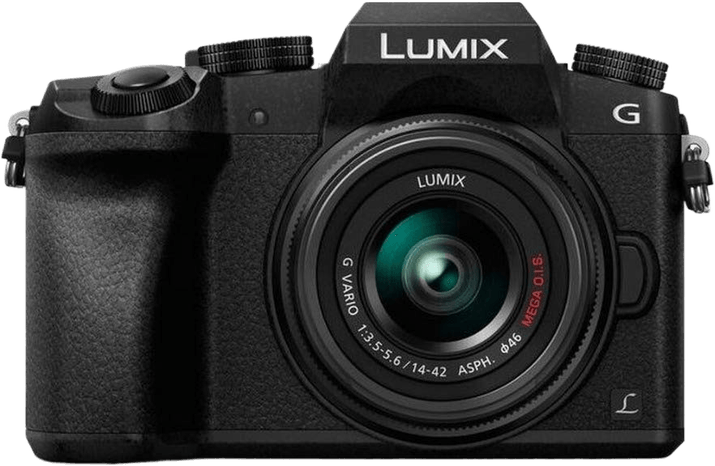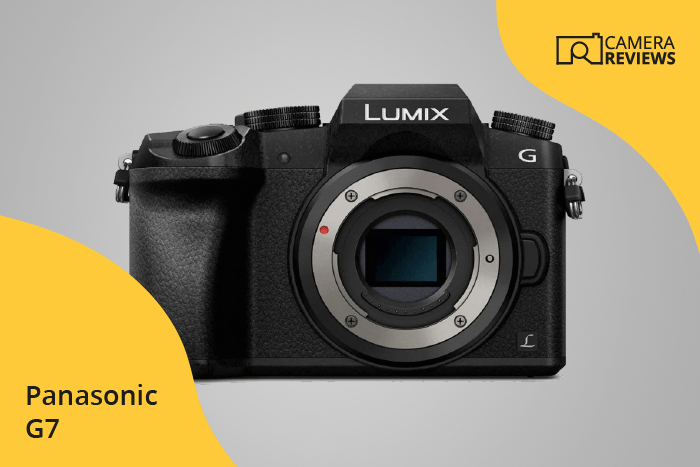Panasonic Lumix DMC-G7 Specs and Scores

The Panasonic Lumix DC-S1H receives a score of 52/100 for its general specifications. This is a relatively older mirrorless camera, released in 2015. Measuring 125 x 86 x 77mm and weighing 410g (.9lbs), the G7 is a decent camera choice, but not a big condender in today’s mirrorless market.
Panasonic Lumix DMC-G7 Overview and Optics
The Panasonic Lumix DMC-G7 receives an optics score of 51/100. This camera features a 16-megapixel CMOS sensor with a Micro Four Thirds size, which is smaller than the more common APS-C sensors found in many competing models. Despite its smaller sensor, the G7’s DXOMARK score is 75, indicating decent performance.
The G7 has a shooting speed of 7 frames per second, which is adequate for casual photography but may be insufficient for fast-paced action or sports photography. This camera utilizes a Micro 4/3 lens mount, offering compatibility with a wide range of lenses. However, the G7 does not have built-in image stabilization, relying on lens-based stabilization instead.
The aspect ratio of the G7 is 4:3, which is standard for Micro Four Thirds cameras but differs from the 3:2 ratio found in many other cameras. The processor remains unspecified, making it difficult to compare with other models. In the competitive camera market, the Panasonic Lumix DMC-G7’s optics specifications are respectable but not outstanding.
Panasonic Lumix DMC-G7 Video Performance
The Panasonic Lumix DMC-G7 boasts a video score of 83/100, which is impressive in the camera market. This score is due to its high-quality video capabilities, which include a max video resolution of 4K and max video dimensions of 3840 x 2160. The camera also offers a max video frame rate of 60fps, providing smooth and detailed footage.
These specifications make the Lumix DMC-G7 a strong contender in today’s competitive market. Additionally, the built-in time-lapse functionality adds to its appeal for those seeking creative video options. With these features, the camera stands out as a reliable choice for both professional and amateur videographers.
The Panasonic Lumix DMC-G7 is a powerful camera with exceptional video capabilities, making it a top choice for users seeking high-quality video performance.
Panasonic Lumix DMC-G7 Features and Benefits
The Panasonic Lumix DMC-G7 receives a feature score of 58/100. This score reflects its 3-inch touchscreen with a resolution of 2360000 dots, which provides clear and sharp visuals. The camera’s flip screen offers flexibility for various shooting angles, making it a versatile choice for photographers.
In today’s market, the G7’s lack of GPS and Bluetooth may limit its appeal for some users. However, the inclusion of Wi-Fi enables easy sharing and remote control of the camera, compensating for these missing features.
When considering its features, the Panasonic Lumix DMC-G7 proves to be a solid camera with a few shortcomings. Its strong points, such as the high-resolution touchscreen and flip screen, make it a suitable option for those who value image quality and versatile shooting angles.
Panasonic Lumix DMC-G7 Storage and Battery
The storage and battery of the Panasonic Lumix DMC-G7 receives a score of 35/100. This camera has one memory card slot, accepting SD, SDHC, and SDXC cards, which is standard in today’s market. However, the battery life is slightly below average, offering 350 shots per charge with the DMW-BLC12E battery type. USB charging is available, providing convenience for users on the go.
Considering the current market, the Panasonic Lumix DMC-G7’s storage and battery specifications are not outstanding. While the memory card compatibility is standard, the battery life falls short in comparison to other cameras. Users seeking longer battery life may need to look at other options.
Panasonic Lumix DMC-G7 Alternatives
Do you want to know how the Panasonic Lumix DMC-G7 compares to its competitors? Have a look at the most popular comparisons for this camera below:
- Panasonic Lumix DMC-G7 vs Lumix DMC-GX7
- Panasonic Lumix DMC-G7 vs Sony a6000
- Panasonic Lumix DMC-G7 vs Lumix DMC-G80
- Canon EOS M50 vs Panasonic Lumix DMC-G7
- Panasonic Lumix DMC-G7 vs Sony a6400
- Canon EOS Rebel T6i / 750D vs Panasonic Lumix DMC-G7
Panasonic Lumix DMC-G7 FAQ
Does the Panasonic Lumix DMC-G7 Have Built-in Image Stabilization?
The Panasonic Lumix DMC-G7 does not have built-in image stabilization. However, it supports lenses with optical image stabilization to help reduce camera shake and blurry images.
Does the Panasonic Lumix DMC-G7 Support 4K Video Recording?
Yes, the Panasonic Lumix DMC-G7 supports 4K video recording at 30fps, providing high-quality videos and the ability to extract 8MP still images from the footage.
What Size Sensor Does The Panasonic Lumix DMC-G7 Have?
The Panasonic Lumix DMC-G7 features a Micro Four Thirds sensor, which is smaller than APS-C sensors but larger than compact camera sensors, offering a good balance between image quality and portability.
Does the Panasonic Lumix DMC-G7 Have a Dual Memory Card Slot?
No, the Panasonic Lumix DMC-G7 has a single memory card slot, supporting SD, SDHC, and SDXC cards for storage of photos and videos.
Does the Panasonic Lumix DMC-G7 Have a Touch Screen?
Yes, the Panasonic Lumix DMC-G7 has a touch screen, which allows for easy navigation of menus, quick focus point selection, and intuitive control of various camera settings.
Does the Panasonic Lumix DMC-G7 Have Wi-Fi and Bluetooth?
The Panasonic Lumix DMC-G7 has built-in Wi-Fi for wireless image transfer and remote camera control, but it does not have Bluetooth connectivity.
Does the Panasonic Lumix DMC-G7 Have GPS?
No, the Panasonic Lumix DMC-G7 does not have built-in GPS for geotagging photos or tracking locations.
Is the Panasonic Lumix DMC-G7 Weather Sealed?
No, the Panasonic Lumix DMC-G7 is not weather sealed, so extra care should be taken when using it in harsh weather conditions or dusty environments.
Does the Panasonic Lumix DMC-G7 Have a Built-in Flash?
Yes, the Panasonic Lumix DMC-G7 has a built-in flash for low-light photography and fill-flash situations, as well as a hot shoe for attaching external flashes and accessories.

